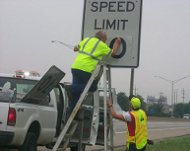Article from: www.thenewspaper.com/news/28/2824.asp
7/1/2009
California Tightens State Speed Trap Regulations
California speed limits may no longer be lowered without a solid engineering justification under new rules.
 As of today, it will be more difficult for California cities to lower speed limits to create lucrative radar speed traps. The California Department of Transportation (Caltrans) has issued a new policy directive that alters the method used to set speed limits, as codified in the state's Manual on Traffic Control Devices (MUTCD). California's speed trap law prohibits the use of radar or laser to issue speeding tickets on any road not in compliance with these new rules.
As of today, it will be more difficult for California cities to lower speed limits to create lucrative radar speed traps. The California Department of Transportation (Caltrans) has issued a new policy directive that alters the method used to set speed limits, as codified in the state's Manual on Traffic Control Devices (MUTCD). California's speed trap law prohibits the use of radar or laser to issue speeding tickets on any road not in compliance with these new rules.
"The setting of speed limits can be controversial and requires a rational and defensible determination to maintain public confidence," the MUTCD explains. "Speed limits are normally set near the 85th-percentile speed that statistically represents one standard deviation above the average speed and establishes the upper limit of what is considered reasonable and prudent. As with most laws, speed limits need to depend on the voluntary compliance of the greater majority of motorists. Speed limits cannot be set arbitrarily low, as this would create violators of the majority of drivers and would not command the respect of the public."
The rules require a regular engineering and traffic survey be used to determine the speed limit. The results of the survey will be rounded to the nearest 5 MPH increment of the speed most drivers in free-flowing traffic are comfortable driving -- the 85th percentile speed. The revised regulation eliminates a provision that allowed the "needs of the community" to be cited as a reason to arbitrarily reduce the speed limit by 5 MPH from the calculated value.
Under the new policy, the 5 MPH reduction can only be made if a registered civil or traffic engineer personally signs off on a study that documents how the reduction was required to address factors that are not "readily apparent" to drivers. For example, if the 85th percentile speed is measured to be 37 MPH, the speed limit must be set at 35 MPH unless a study shows a specific, objective factors indicating a need to reduce it to 30 MPH.
Chad Dornsife, Executive Director of the Best Highway Safety Practices Institute says the net result of this change is that it will be more difficult for jurisdiction to make that 5 MPH reduction. He argues further that the 85th percentile speed is by definition always the safest speed because it is based on the consensus of those who know the road best.
"'Conditions not readily apparent' when applied to a local surface street or residential collector is an oxymoron," Dornsife said. "By definition the primary users of this classification of roadway are the people who live or work there, and they use these very same roadways many times a day, going and coming. Therefore, the conditions are not only apparent to the primary users, they are well known. Whereas under current practice, the traffic engineer's opinion is based of a few hours of observation at best."
Caltrans made the change to standardize procedures across the state after a lengthy consultation process with law enforcement and local agencies. Many jurisdictions that began arbitrarily lowering speed limits by 5 MPH in 2004 had their citations thrown out in court. The new regulations are intended to create tickets that will withstand court scrutiny. Cities with red light cameras that raise speed limits to comply with the law will also need to increase the yellow time at affected intersections.
A copy of the new regulation is attached in a 600k PDF file at the source link below.
Source: Policy Directive TR-0011 (California Department of Transportation, 7/1/2009)
Permanent Link for this item
Return to Front Page
 As of today, it will be more difficult for California cities to lower speed limits to create lucrative radar speed traps. The California Department of Transportation (Caltrans) has issued a new policy directive that alters the method used to set speed limits, as codified in the state's Manual on Traffic Control Devices (MUTCD). California's speed trap law prohibits the use of radar or laser to issue speeding tickets on any road not in compliance with these new rules.
As of today, it will be more difficult for California cities to lower speed limits to create lucrative radar speed traps. The California Department of Transportation (Caltrans) has issued a new policy directive that alters the method used to set speed limits, as codified in the state's Manual on Traffic Control Devices (MUTCD). California's speed trap law prohibits the use of radar or laser to issue speeding tickets on any road not in compliance with these new rules.